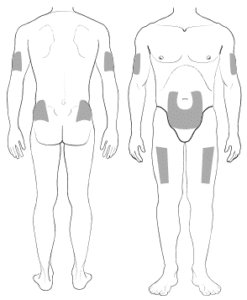
Speak to a Chemo Specialist
What Is Pegfilgratism (Neulasta)?
Pegfilgrastim (pronounced [peg fil GRA stim]), which is also known by the brand name, Neulasta, is a hematopoietic agent that is used to treat neutropenia. Neulasta was the first medication produced based on the active element pegfilgrastim. Pegfilgrastim is not a hazardous drug, nor is it a form of chemotherapy. Several different biosimilars based on Neulasta have been produced to date.
What Is Neutropenia?
Neutropenia occurs when you have too few neutrophils, a type of white blood cell that helps our bodies fight off infections. Having neutropenia indicates a higher risk of developing serious bacterial and fungal infections. Neutropenia is a very common side effect of cancer patients undergoing chemotherapy.
Febrile neutropenia is a more serious condition where the neutrophil count drops to a dangerously low level where there are not enough white blood cells to fight off infections. This could potentially lead to life-threatening infections.
Mechanism of Action
Pegfilgrastim is a blood cell colony-stimulating agent (CSA) and has been used successfully by cancer patients to stimulate the growth of white blood cells, more specifically neutrophils. It does this by stimulating the production of neutrophils directly from the bone marrow.
Speak to a Specialist About Copay Assistance
How is Neulasta Used?
Available Formulations
Neulasta is only available as a subcutaneous (under the skin) injection or as a specialized skin patch (also known as an on-body injector [OBI] or Neulasta OnPro). Neulasta injection is available as a single-use prefilled syringe for subcutaneous injection at a dose of 6 mg/0.6 ml.
Subcutaneous Injection
The injection sites can include upper areas of the buttocks, front of the thighs, lower abdomen area (2 inches away from the navel), or the upper outer arms. Do not inject into areas where the skin is tender, bruised, red, scaly, or hard, and avoid areas with scars or stretch marks. After injection, do not rub the injection site. Do not handle the prefilled syringe if you are allergic to latex, and do not save unused medication in the prefilled syringe for later use. You should not attempt to give yourself a subcutaneous injection until you have received the appropriate training from your healthcare provider.
Specialized Skin Patch (On-Body Injector, OBI)
The Neulasta OnPro Patch is a system that your health care provider will program to automatically deliver the drug into the body about 27 hours after chemotherapy. This is convenient for many patients because it saves them a trip to the doctor’s office the day after receiving chemotherapy.
Missed Dose
If you miss a dose, contact your physician immediately to reschedule. If the OBI malfunctions and fails to deliver medication as scheduled, consult your physician immediately to schedule for the administration of a manual injection as soon as possible.
Storage
Store Neulasta in the refrigerator and avoid freezing. If frozen, thaw in the refrigerator before use. Neulasta should be thawed (taken out of the refrigerator) for 30 minutes at room temperature before injecting. It can be left at room temperature for up to 48 hours. Do not shake the vials, and keep them protected from light by storing them in their original containers. The OBI kit should be kept refrigerated until 30 minutes prior to use and should not be left at room temperature for more than 12 hours.
Disposal
Dispose of Neulasta if it has been left at room temperature for more than 48 hours for the syringe or 12 hours for the OBI kit. Dispose of Neulasta if it has been frozen more than once. After injection, dispose of any unused Neulasta left in the prefilled syringe. Be sure to dispose of the pre-filled syringes in an FDA-cleared sharps disposal container (not in the household trash).
Get Chemotherapy Copay Assistance
Chemotherapy Financial AssistanceWhat To Avoid While Taking Pegfilgrastim
While on pegfilgrastim therapy, you must follow some precautions. Always tell your physician about any medication you are already taking. Do not take any drug or medicine (even herbals or over-the-counter medications) without prior consent from your physician or pharmacist, as they may have interactions with Neulasta. Avoid taking Neulasta within 14 days before or 24 hours after having chemotherapy.
Pregnancy and Neulasta
Pregnant women, women who are planning to become pregnant, and breastfeeding women must consult a physician prior to initiating Neulasta. The risk to the fetus or baby is unknown.
Side Effects
As with any other medication, you may encounter side effects while taking pegfilgrastim. A few things to keep in mind are:
- You may not have all the side effects listed below. Many people may experience little to no side effects.
- The severity of side effects may vary from person to person, so do not compare your side effects with other people’s experiences.
- Most of the side effects will improve when therapy is discontinued.
- Do not hide any symptoms; when you feel any discomfort, do not hesitate to tell your physician or pharmacist about it.
Note: The side effects listed below are not a comprehensive list of all side effects. Talk to your doctor if you have questions.
Some of the more serious side effects of Neulasta are:
Injection-site Pain
Most needles are painful, but Neulasta is especially known for causing some pain in the injection site, even for a while after the injection is complete. This is also often accompanied by mild bruising, swelling, or redness at the injection site.
Injection site pain can be controlled using over-the-counter painkillers such as Tylenol or Motrin, but usually, they resolve on their own within a few days. Consult your doctor or pharmacist prior to starting any new over-the-counter therapies.
Bone and Muscle Aches
This is the most common side effect of Neulasta since it stimulates the bone marrow (a spongy substance found inside of bone), causing it to swell and cause potential bone pain. It commonly starts about 1 to 2 days after receiving a Neulasta dose and can last up to a week, depending on the person.
Bone or muscle pains can be controlled using over-the-counter painkillers such as Tylenol or Motrin. Consult your doctor or pharmacist before starting any new over-the-counter therapies.
Consult a Chemotherapy Specialist
Get Chemotherapy Treatment AssistanceThrombocytopenia, Leukocytosis
It is essential to keep up with regular blood tests, especially the complete blood count test (CBC). The CBC blood test is capable of detecting potential side effects of Neulasta, including leukocytosis (high white blood cells level) and thrombocytopenia (low platelet count). Contact your physician if any unusual bleeding or bruising occurs.
Lung Problem Called Acute Respiratory Distress Syndrome (ARDS)
Contact a physician or get emergency medical help right away if you have shortness of breath with or without a fever, trouble breathing, or a fast rate of breathing.
Kidney Injury
Call your doctor right away if you experience puffiness in your face or ankles, blood in your urine, or brown-colored urine. Also, contact your doctor if you notice you urinate less than usual.
Capillary Leak Syndrome (CLS)
Neulasta can cause fluid to leak from blood vessels into your body’s tissues. CLS can quickly cause you to have symptoms that may become life-threatening. Get emergency medical help right away if you develop any of the following symptoms: swelling or puffiness, urinating less often, trouble breathing, swelling of the abdominal area, and feeling of fullness, dizziness, or faintness.
Inflammation of Blood Vessels
Contact your physician if you develop purple spots or redness on your skin.
Rupture of the Spleen
A ruptured spleen is one of the most severe side effects of Neulasta. The spleen may become enlarged and may possibly rupture, which can be fatal. Call your doctor right away if you have pain in the upper left stomach (abdomen) or your left shoulder.
Less severe side effects can include:
- Sweating
- Dark Urine
Get Chemotherapy Copay Assistance
Chemotherapy Financial AssistancePrecautions
Unless approved by your physician, pegfilgrastim is generally not recommended for:
- Patients who have an allergy to human granulocyte colony-stimulating factors (CFS) such as filgrastim or pegfilgrastim products. Allergic reactions can cause a rash over the whole body, shortness of breath, wheezing, dizziness, swelling around your mouth or eyes, fast heart rate, and sweating. If you have any of these symptoms, stop using Neulasta, and call your doctor or get emergency help right away.
- Patients with sickle cell disorder. Using Neulasta can lead to a condition called sickle cell crisis, which may be life-threatening and require discontinuation of Neulasta.
- Patients receiving radiation therapy. Neulasta may increase the risk of developing a precancerous condition called myelodysplastic syndrome (MDS) or a type of blood cancer called acute myeloid leukemia (AML).
FAQs
Is Neulasta a chemo agent?
No, it is not a chemotherapy agent. Instead, it helps treat a major side effect of chemotherapy called neutropenia (low white blood cell count). Chemotherapy drugs are directed at combating your cancer cells, while Neulasta is designed to combat the after-effects of a chemotherapy session.
How is Neulasta taken?
Neulasta is only available as an injection. It can be injected subcutaneously (under the skin) or as a specialized skin patch (also known as an on-body injector [OBJ] or Neulasta OnPro) programmed by a healthcare provider. You should not attempt to give yourself a subcutaneous injection until you have received the appropriate training from your healthcare provider.
REFERENCES:
Burris, H. A., Belani, C. P., Kaufman, P. A., Gordon, A. N., Schwartzberg, L. S., Paroly, W. S., Shahin, S., Dreiling, L., & Saven, A. (2016, September 21). Pegfilgrastim on the Same Day Versus Next Day of Chemotherapy in Patients With Breast Cancer, Non–Small-Cell Lung Cancer, Ovarian Cancer, and Non-Hodgkin’s Lymphoma: Results of Four Multicenter, Double-Blind, Randomized Phase II Studies. Journal of Oncology Practice. 2010 6:3, 133-140. Retrieved November 5, 2021, from https://ascopubs.org/doi/10.1200/JOP.091094
Cancer Statistics. (2020, September 25). National Cancer Institute. Retrieved November 5, 2021, from https://www.cancer.gov/about-cancer/understanding/statistics
FastStats. (2021, October 19). Leading Causes of Death. Retrieved November 5, 2021, from https://www.cdc.gov/nchs/fastats/leading-causes-of-death.htm
Highlights of Prescribing Information. (2019, April). Food and Drug Administration (FDA). Retrieved November 5, 2021, from https://www.accessdata.fda.gov/drugsatfda_docs/label/2019/125031s198lbl.pdf
Instructions for Use Neulasta (Pegfilgrastim). (2016, December). Amgen – Neulasta. Retrieved November 5, 2021, from https://www.pi.amgen.com/~/media/amgen/repositorysites/pi-amgen-com/neulasta/neulasta_pfs_ifu.ashx
Neulasta® (pegfilgrastim) Onpro®. (2021). Resources by Amgen. Retrieved November 5, 2021, from https://www.neulasta.com/resources/
Neulasta: Drug Information. (2018, April 30). Breastcancer.Org. Retrieved November 5, 2021, from https://www.breastcancer.org/treatment/druglist/neulasta
Neulasta: Uses, dosage, side effects, warnings. Drugs.com. (n.d.). Retrieved November 4, 2021, from https://www.drugs.com/Neulasta.html.
Pegfilgrastim (Subcutaneous Route) Side Effects – Mayo Clinic. (2021, February 1). Mayo Clinic. Retrieved November 5, 2021, from https://www.mayoclinic.org/drugs-supplements/pegfilgrastim-subcutaneous-route/side-effects/drg-20066866?p=1
Pegfilgrastim. In: Lexi-drugs online [database on the Internet]. Hudson (OH): Lexicomp, Inc.; 2016 [updated 329 Oct 2021; cited 4 Nov 2021]. Available from: http://online.lexi.com
Pegfilgrastim. In: In Depth Answers [database on the Internet]. Greenwood Village (CO): IBM Corporation; 2017 [cited 2021 Nov 4]. Available from: www.micromedexsolutions.com
Weiser, P. P. (2021, May 6). All About Neulasta. Healthline. Retrieved November 5, 2021, from https://www.healthline.com/health/drugs/neulasta#what-it-is














